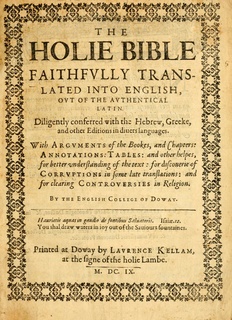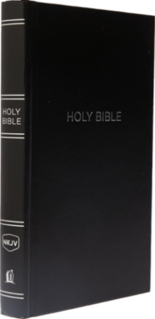
The King James Version (KJV), also the King James Bible (KJB) and the Authorized Version, is an English translation of the Christian Bible for the Church of England, which was commissioned in 1604 and published in 1611, by sponsorship of King James VI and I. The 80 books of the King James Version include 39 books of the Old Testament, an intertestamental section containing 14 books of what Protestants consider the Apocrypha, and the 27 books of the New Testament. Noted for its "majesty of style", the King James Version has been described as one of the most important books in English culture and a driving force in the shaping of the English-speaking world.

The New World Translation of the Holy Scriptures (NWT) is a translation of the Bible published by the Watch Tower Bible and Tract Society. The New Testament portion was released in 1950, as The New World Translation of the Christian Greek Scriptures, with the complete Bible released in 1961; it is used and distributed by Jehovah's Witnesses. Though it is not the first Bible to be published by the group, it is their first original translation of ancient Biblical Hebrew, Koine Greek, and Old Aramaic biblical texts. As of March 2, 2020, the Watch Tower Society has published more than 220 million copies of the New World Translation in whole or in part in 200 languages. Though commentators have said a scholarly effort went into the translation, critics have described it as biased.

The Great Bible of 1539 was the first authorised edition of the Bible in English, authorised by King Henry VIII of England to be read aloud in the church services of the Church of England. The Great Bible was prepared by Myles Coverdale, working under commission of Thomas, Lord Cromwell, Secretary to Henry VIII and Vicar General. In 1538, Cromwell directed the clergy to provide "one book of the Bible of the largest volume in English, and the same set up in some convenient place within the said church that ye have care of, whereas your parishioners may most commodiously resort to the same and read it."

Textus Receptus refers to all printed editions of the Greek New Testament from Erasmus' Novum Instrumentum omne (1516) to the 1633 Elzevir edition. It was the most commonly used text type for Protestant denominations.

The Revised Standard Version (RSV) is an English translation of the Bible published in 1952 by the Division of Christian Education of the National Council of the Churches of Christ in the USA. This translation itself is a revision of the American Standard Version (ASV) of 1901, and was intended to be a readable and literally accurate modern English translation which aimed to "preserve all that is best in the English Bible as it has been known and used through the centuries" and "to put the message of the Bible in simple, enduring words that are worthy to stand in the great Tyndale-King James tradition."

The Revised Version (RV) or English Revised Version (ERV) of the Bible is a late 19th-century British revision of the King James Version. It was the first and remains the only officially authorised and recognised revision of the King James Version in Great Britain. The work was entrusted to over 50 scholars from various denominations in Great Britain. American scholars were invited to co-operate, by correspondence. Its New Testament was published in 1881, its Old Testament in 1885, and its Apocrypha in 1894. The best known of the translation committee members were Brooke Foss Westcott and Fenton John Anthony Hort; their fiercest critics of that period were John William Burgon and George Saintsbury.
Partial Bible translations into languages of the English people can be traced back to the late 7th century, including translations into Old and Middle English. More than 100 complete translations into English have been written.

The Douay–Rheims Bible, also known as the Douay–Rheims Version, Rheims–Douai Bible or Douai Bible, and abbreviated as D–R, DRB, and DRV, is a translation of the Bible from the Latin Vulgate into English made by members of the English College, Douai, in the service of the Catholic Church. The New Testament portion was published in Reims, France, in 1582, in one volume with extensive commentary and notes. The Old Testament portion was published in two volumes twenty-seven years later in 1609 and 1610 by the University of Douai. The first volume, covering Genesis through Job, was published in 1609; the second, covering Psalms to 2 Maccabees plus the three apocrypha books of the Vulgate appendix following the Old Testament was published in 1610. Marginal notes took up the bulk of the volumes and had a strong polemical and patristic character. They offered insights on issues of translation, and on the Hebrew and Greek source texts of the Vulgate.

The New Living Translation (NLT) is an English translation of the Bible. The origin of the NLT came from a project aiming to revise The Living Bible (TLB). This effort eventually led to the creation of the NLT—a new translation separate from the LB. The NLT relies on critical editions of the original Hebrew and Greek texts. The first NLT edition retains some stylistic influences of the LB, but these are less evident in text revisions that have been published since.
Early Modern English Bible translations are those translations of the Bible which were made between about 1500 and 1800, the period of Early Modern English. This was the first major period of Bible translation into the English language including the King James Version and Douai Bibles. The Reformation and Counter-Reformation led to the need for Bibles in the vernacular with competing groups each producing their own versions.

The New King James Version (NKJV) is an English translation of the Bible. The complete NKJV Bible was published in 1982 by Thomas Nelson, now HarperCollins. The NKJV is described by Thomas Nelson as being "scrupulously faithful to the original, yet truly updated to enhance its clarity and readability."

The Complutensian Polyglot Bible is the name given to the first printed polyglot of the entire Bible. The edition was initiated and financed by Cardinal Francisco Jiménez de Cisneros (1436–1517) and published by Complutense University in Alcalá de Henares, Spain. It includes the first printed editions of the Greek New Testament, the complete Septuagint, and the Targum Onkelos. Of the 600 six-volume sets which were printed, only 123 are known to have survived to date.

The Nova Vulgata, also called the Neo-Vulgate, is the official Classical Latin translation of the original-language texts of the Bible published by the Holy See. It was completed in 1979, and was promulgated the same year by John Paul II in Scripturarum thesaurus. A second, revised edition was published in 1986. It is the official Latin text of the Bible of the Catholic Church. The Nova Vulgata is also called the New Latin Vulgate or the New Vulgate.

Novum Testamentum Graece is a critical edition of the New Testament in its original Koine Greek, forming the basis of most modern Bible translations and biblical criticism. It is also known as the Nestle–Aland edition after its most influential editors, Eberhard Nestle and Kurt Aland. The text, edited by the Institute for New Testament Textual Research, is currently in its 28th edition, abbreviated NA28.

Bible translations into Chinese include translations of the whole or parts of the Bible into any of the levels and varieties of the Chinese language. The first translations may have been made as early as the 7th century AD, but the first printed translations appeared only in the nineteenth century. Progress on a modern translation was encumbered by denominational rivalries, theological clashes, linguistic disputes, and practical challenges at least until the publication of the Protestant Chinese Union Version in 1919, which became the basis of standard versions in use today.
Dr. Richard Francis Weymouth (1822–1902) was an English schoolmaster, Baptist layman and Bible student known particularly for producing one of the earliest modern language translations of the New Testament.
The Concordant Version is an English translation of the Bible compiled by the Concordant Publishing Concern (CPC), which was founded by Adolph Ernst Knoch in 1909. The principal works of the CPC are the Concordant Literal New Testament with Keyword Concordance ("CLNT") and the Concordant Version of the Old Testament ("CVOT"). A. E. Knoch designed the Concordant Version in such a way as to put the English reader who lacks a formal knowledge of Koine Greek in possession of all the vital facts of the most ancient codices: Codex Vaticanus, Codex Sinaiticus, and Codex Alexandrinus. The CPC's efforts yielded a restored Greek text, titled The Concordant Greek Text, containing all of the important variant readings found in the codices mentioned above. This was done with the intent of conforming, as far as possible, to the original autograph manuscripts. An utterly consistent hyper-literal sub-linear based upon a standard English equivalent for each Greek element is to be found beneath each Greek word. The Concordant Greek Text forms the basis of the Concordant Literal New Testament, which is more idiomatic in its English than the hyper-literal sublinear. The Concordant Literal New Testament and the Concordant Greek Text are linked together and correlated for the English reader by means of an English concordance—the Keyword Concordance—and a complementary list of the Greek elements.
Bible translations into French date back to the Medieval era. After a number of French Bible translations in the Middle Ages, the first printed translation of the Bible into French was the work of the French theologian Jacques Lefèvre d'Étaples in 1530 in Antwerp, Duchy of Brabant, Habsburg Netherlands. This was substantially revised and improved in 1535 by Pierre Robert Olivétan. This Bible, in turn, became the basis of the first French Catholic Bible, published at Leuven in 1550, the work of Nicholas de Leuze and François de Larben. See also the Douay–Rheims Bible whose New Testament was published in 1582, and Old Testament, in two volumes, in 1609 and 1610 by the University of Douai. Finally, the Bible de Port-Royal, prepared by Antoine Lemaistre and his brother Louis Isaac Lemaistre, finished in 1695, achieved broad acceptance among both Catholics and Protestants. Jean-Frédéric Ostervald's version (1744) also enjoyed widespread popularity.
The Twentieth Century New Testament (TCNT) is an English translation of the New Testament. Originally published in three parts between 1898 and 1901, it is considered the first translation of the Bible into present-day English. After further revisions based on suggestions from readers, the final version was published in 1904.

The New American Bible Revised Edition (NABRE) is an English-language Catholic translation of the Bible, the first major update in 20 years to the New American Bible (NAB), which was translated by members of the Catholic Biblical Association and originally published in 1970. Released on March 9, 2011, the NABRE consists of the 1986 revision of the NAB New Testament with a fully revised Old Testament approved by the United States Conference of Catholic Bishops in 2010.














